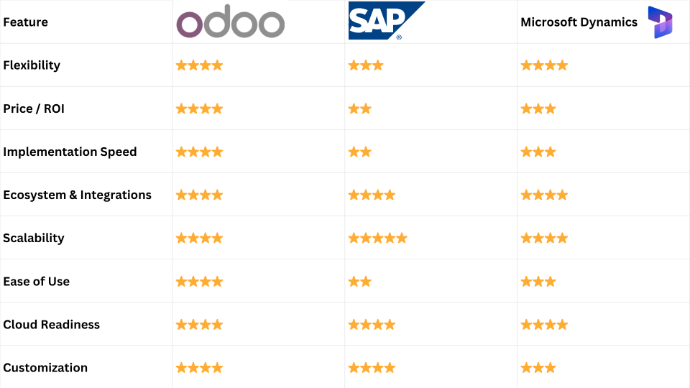Flexibility & Modularity
Odoo: Known for its modular architecture, Odoo allows you to start small and scale as needed. Whether it’s CRM, accounting, inventory, HR, or even eCommerce—everything is seamlessly integrated in one platform. Open-source flexibility is a major advantage.
SAP: A powerhouse in the enterprise world, SAP is highly capable but often complex. It’s built for large enterprises with highly specific and regulated processes. Implementation is typically lengthy and costly.
Microsoft Dynamics: A solid mid-market solution with strong integration across the Microsoft ecosystem (Office 365, Teams, Power BI). It offers good modularity, but customization often depends on external partners.
Ease of Implementation & Maintenance
Odoo: Fast to implement with the right partner. Thanks to its modern UI and all-in-one approach, users adapt quickly. Partners like 26HOUSE offer 24/7 support, hosting, and maintenance for both Odoo EE and CE.
SAP: Requires extensive planning and change management. High dependency on certified consultants.
Microsoft Dynamics: Implementation is easier than SAP but still requires skilled consultants and long project timelines.

Cost & ROI
Odoo: Highly competitive pricing, especially for small to mid-sized businesses. Offers both Community (free, open source) and Enterprise editions. Fast deployment and lower TCO (total cost of ownership) result in a faster return on investment.
SAP: Premium pricing model. Licensing, infrastructure, and maintenance can be costly. Best suited for enterprises with a large IT budget and dedicated teams.
Microsoft Dynamics: Mid-range pricing, but total cost can increase with third-party add-ons, customizations, and Microsoft Azure hosting fees.
Ecosystem & Integrations
Odoo: Over 39,000+ apps in its ecosystem. Built-in eCommerce, website builder, marketing automation, and more. Open-source nature allows for custom development without vendor lock-in.
SAP: Strong in manufacturing, logistics, and finance-heavy sectors. Integrates with major enterprise solutions but less flexible for rapid changes.
Microsoft Dynamics: Tight integration with Microsoft products is a plus. Limited native functionality outside traditional ERP scope—relies on third-party add-ons.

Summary:
Which ERP System Is Right for Your Business?
Odoo
Advantages:
Highly modular – you only use the apps you need
Fast and cost-effective implementation
Very affordable (including free Community edition)
Open-source = flexibility and no vendor lock-in
Modern user interface and intuitive UX
Disadvantages:
Requires a strong implementation partner to fully unlock its potential
Poor configuration may lead to underwhelming results
Recommendation:
✅ Best fit for small and medium-sized businesses looking for a scalable, flexible, and budget-friendly ERP
✅ Also suitable for larger companies wanting to move away from legacy systems and adopt modern technology
SAP (e.g., S/4HANA)
Advantages:
Extremely robust and time-tested solution
Excellent for complex operations (manufacturing, logistics, finance, regulated industries)
Strong brand trust and global support
Disadvantages:
High cost of licensing, implementation, and maintenance
Long and complex implementation cycles
Less flexible when it comes to quick changes or custom workflows
Recommendation: ✅ Ideal for large enterprises and multinational corporations with big budgets and highly specific operational needs ❌ Not recommended for small businesses – too complex and expensive
Microsoft Dynamics 365
Advantages:
Seamless integration with Microsoft tools (Office 365, Teams, Power BI, Azure)
Solid ERP and CRM capabilities
Strong cloud-based architecture
Disadvantages:
Can become expensive due to additional modules and customizations
Limited built-in functionality outside core modules; relies on third-party extensions
Custom development often requires external consultants
Recommendation: ✅ Great for mid-sized companies already invested in the Microsoft ecosystem ⚠️ Not as modular or affordable as Odoo for early-stage businesses